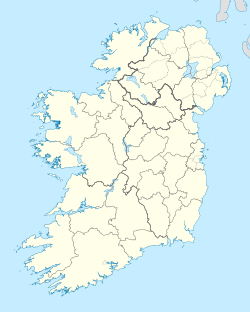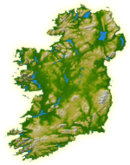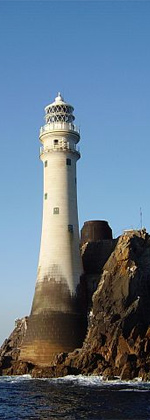Mizen Head
Mizen Head
Carn Uí Néid | |
|---|---|
 Mizen Head, the most southwesterly point of Ireland | |
| Coordinates: 51°27′1″N 9°49′10″W / 51.45028°N 9.81944°W / 51.45028; -9.81944 | |
| Grid position | D180438 |
| Location | County Cork, Ireland |
| Native name | Carn Uí Néid |
| Elevation | 101.63 m (333.43 ft) [1] |
Mizen Head (Irish: Carn Uí Néid)[2] is traditionally regarded as the most southerly point of mainland Ireland although Brow Head is the actual southernmost point. It is at the end of the Mizen Peninsula in the district of Carbery in County Cork.
Geography
Mizen Head is one of the extreme points of the island of Ireland and is a major tourist attraction, noted for its dramatic cliff scenery. One of the main transatlantic shipping routes passes close by to the south, and Mizen Head was, for many seafarers, the first (or last) sight of Europe.
The tip of the peninsula is almost an island, cut off by a deep chasm, now spanned by a bridge; this gives access to an old signal station, a weather station, and a lighthouse. The signal station, once permanently staffed, is now a museum housing displays relating to the site's strategic significance for transatlantic shipping and communications, including the pioneering efforts of Guglielmo Marconi. The "99 steps" which formed part of the original access route have been supplemented by a series of paths and viewing platforms, and a full range of visitor facilities is available at the entrance to the site. The villages of Ballydehob, Crookhaven, Goleen, and Schull are located on the peninsula to the east.
.jpg/440px-MizenHead_IMG_2699_(2).jpg)
Nearby Brow Head, also on the Mizen Peninsula and a short distance to the east, is several metres further south than Mizen Head. Nevertheless, geography books have long measured the length of Ireland, diagonally northeast-to-southwest, as "from Fair Head to Mizen Head"[3] or north-to-south "from Malin Head to Mizen Head".[4]
History
Ptolemy's Geography (2nd century AD) referred to the point as the "southern headland" (Ancient Greek: Νότιον ἄκρον, romanized: Notion akron).[5][6]
The headland's Irish name, Carn Uí Néid, means "cairn of Néid's grandson". This refers to Balor, a leader of the Fomorians in Irish mythology. In a tale dating from at least the 12th century, the god Lugh defeats Balor in combat and chases him to Mizen Head. There, Lugh beheads Balor and sets the severed head on a large rock, which then shatters.[7]
See also
References
- ^ "Mizen Head Elevation (101.63 M)". Distancesto.com. 2017.
elevation 101.63 m
- ^ "Carn Uí Néid/Mizen Head". Placenames Database of Ireland. Retrieved 27 January 2024.
- ^ Robert Johnson. The Competitive Geography (1877). p. 170.
- ^ William Hughes and John Williams. A Class-book of Modern Geography (1885). p. 78.
- ^ Ptolemy. The Geography. Vol. 2.2.5.
- ^
 Smith, William, ed. (1854–1857). "Notium". Dictionary of Greek and Roman Geography. London: John Murray.
Smith, William, ed. (1854–1857). "Notium". Dictionary of Greek and Roman Geography. London: John Murray.
- ^ Ó hÓgáin, Dáithí (1991). Myth, Legend & Romance: An encyclopaedia of the Irish folk tradition. Prentice Hall. pp. 43–45. ISBN 9780132759595.
Sources
- Mizen Journal, Archaeology Paddy O'Leary, No 11, 2003 ISSN 1649-203X
- Archaeological Inventory of County Cork, Vol 1 West Cork, Office of Public Works, 1992 ISBN 0-7076-0175-4
- BHAS Journal vol 2 p.106-119, Townlands Donal Fitzgerald ISSN 0791-6612
- Northside of the Mizen, General reading, Patrick McCarthy & Richard Hawkes
External links
- Mizen Head Pictures and Travel Guide



